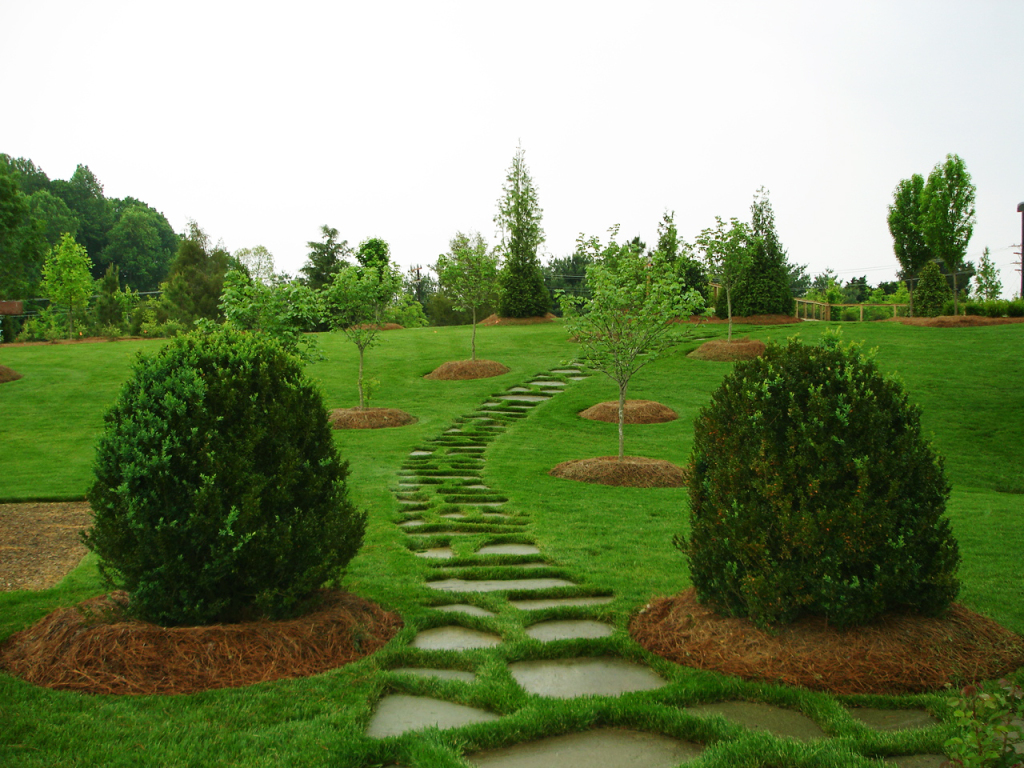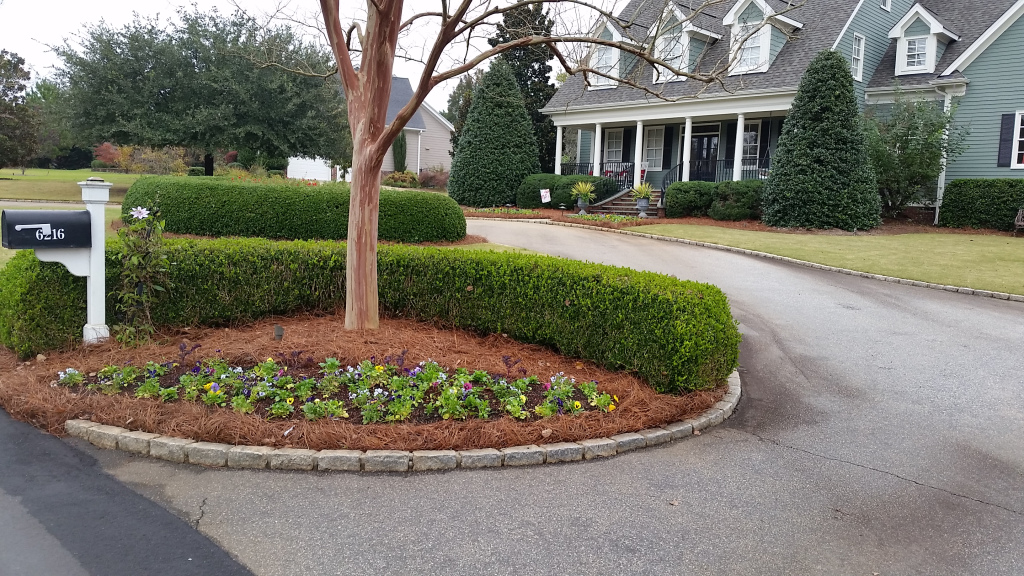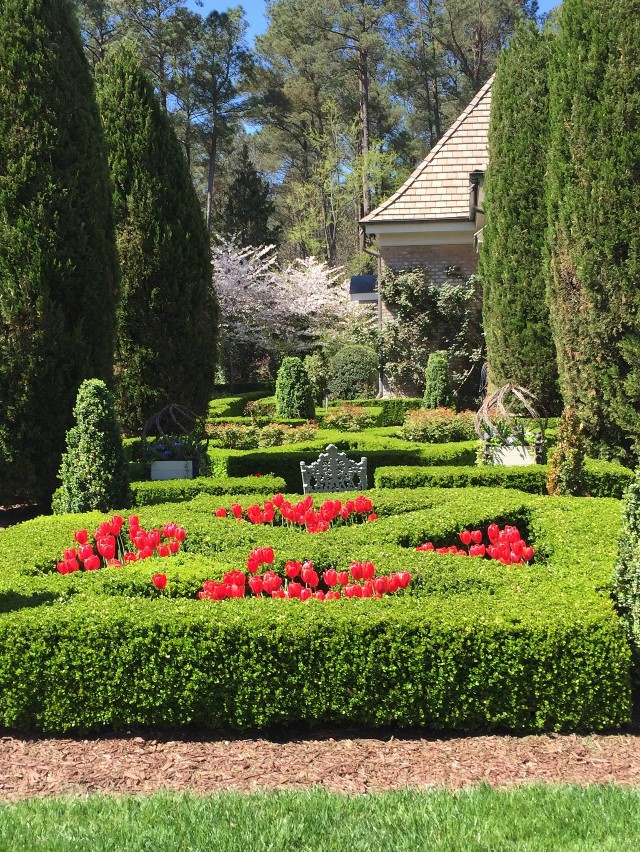Boxwoods are one of the most ubiquitous shrubs in the American garden. They have been popular for centuries throughout Europe and the US, because they are so versatile; boxwoods can be pruned into elaborate topiaries, sheared into formal hedges, or allowed to grow naturally as elegant evergreen accents in the landscape. There are several varieties of boxwood--multiple species, hybrids, and cultivars within those groups, but they all share similarities. Today we're going to touch on proper pruning techniques, a threatening new disease to watch out for, and identification tips for the most common types of boxwood.
 Large natural boxwoods in the landscape.
Large natural boxwoods in the landscape.
Photo credit: Herbie Champion
Pruning Tips
There are two main methods of pruning to use with boxwoods: thinning and shearing. Thinning is important for maintaining the health of all boxwoods, while shearing is used to sculpt the shrubs into a desired shape, which is purely a personal choice, and may look rather artistic (or horrifying if done poorly!). In addition, shearing without ever thinning can cause a lot of issues both for the health and appearance of boxwoods.
Thinning only needs to be done once a year in the spring, after the cold weather ends but before the shrubs are fully leafed out, usually between mid-February to May 1st, depending on your location. In coastal South Carolina, pruning could begin earlier, while residents in the mountains of North Carolina will want to wait as late as possible.
Thinning involves removing branches evenly all over the shrub to increase light penetration and air circulation within the center of the shrub. Essentially, leaves will not grow where there is no light, because it's a waste of the plant's energy. But it's important to encourage growth in the interior, because the more leaves a plant has, the more food it can produce for itself, and therefore the more it will be able to grow and the healthier it will be. Additionally, poor air circulation encourages fungal diseases and insect infestation, so keeping a more open interior will help reduce pest and disease issues. To determine if your boxwoods need to be thinned, try parting the branches. If the shrub is so dense that it's difficult to part the branches and look into the interior, you definitely need to thin. If when you part the branches, you see green growth only on the last few inches of each branch, you definitely need to thin. When you become more familiar with the process, you will be able to tell just by brushing your fingers over a boxwood specifically where it needs to be thinned.
To thin, just remove select branches, going deep into the interior of the shrub. A good rule of thumb is to only remove sections that are the length of the green growth. For example, if there are leaves going back about 8 inches on a branch, then remove 8" sections in little pockets all over the top and sides of the shrub. It should look looser and even all over.
For more details about thinning, check out this article.
Shearing is done to shape formal hedges and create topiaries. It is done purely for aesthetic reasons, and does not improve the health of the plant in any way, and when done incorrectly, can be harmful to the plant. When shearing, be careful not to remove too much at once, especially if the shrubs have not been thinned, or you will end up with a brown twiggy skeleton of a shrub. In order to maintain tight formal hedges, they may need to be sheared a few times during the growing season. Make sure to thin the shrubs in the spring before vigorous growth begins, and avoid shearing during very hot periods. Shearing will encourage new growth, which will stress the plant during high temperatures.
To see some amazing, world-famous topiaries, check out Pearl Fryer's garden in Bishopville, South Carolina. It's open Tuesday-Saturday from 10am-4pm, year round. There is no entrance fee, but donations are encouraged. The collection includes boxwoods, but also a multitude of other species.
Boxwood Blight
Boxwood Blight is a fairly new fungal disease with the potential to wipe out boxwood populations on the east coast. It's currently in Pennsylvania and other northern states, but could move to NC and SC. You can read in-depth information here, in a publication by NC State. Avoid bringing this disease to your property by only buying boxwoods from reputable sources and disposing of boxwood products such as live wreaths or stems from floral arrangements in the trash, and not in your compost.
 Boxwood hedges can form lovely backdrops for other showier plants, such as annual flower plantings.
Boxwood hedges can form lovely backdrops for other showier plants, such as annual flower plantings.
Photo credit: Misael Gonzalez
ID Tips
- Most people are familiar with boxwoods, which are evergreen and have small leaves, with no prickles, thorns, or cones.
- Boxwoods are most often confused with Japanese holly, which is also evergreen with no prickles, and has leaves of a similar size and shape. A simple feature to tell boxwoods and hollies apart is the leaf arrangement: boxwoods will always have leaves in opposite pairs, while the leaves of hollies will always alternate along the stems.
- Boxwood leaves have smooth edges, while Japanese holly leaves have "crenate margins", meaning the edges are scalloped.
- What is the difference between English, American, Japanese, and Korean boxwoods? Well, English and American boxwood are the same species, Buxus sempervirens, and Korean boxwood (Buxus microphylla var. koreana) is actually a variety of the Japanese boxwood species (Buxus microphylla). The English/American boxwood differs from the Japanese/Korean boxwoods in many ways, but the easiest way to tell is that the tip of the leaf is pointed, while Asian boxwoods have a rounded point with a small indentation at the very tip (like the shape of a rounded "W").
 Formal gardens with tulips and boxwoods.
Formal gardens with tulips and boxwoods.
Photo credit: Robby Tackett